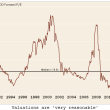From Goldman Sachs:
Trade Update: Top Trade Recommendation No. 9: Long UK Equities (FTSE 100 Dec 13 Future)
We are recommending going long UK equities via the FTSE 100 Dec 13 Future for a target of 7100 (approximately +12%) and a stop on a close below 5950 (approximately 6% below the current level). We noted the strong arguments in favour of UK equities for the second half of the year in our recent Global Economics Weekly, and we now follow up with a trade recommendation. Three primary reasons drive this recommendation.
First, the UK economy looks to be on an upswing. The manufacturing PMI surveys have now improved for four successive months, while the services PMI survey has improved for six consecutive months and has reached its highest level since March 2011. Mortgage approvals have also risen in recent months as effective interest rates have fallen, and the latest quarterly credit survey for Q2 indicates a further easing in household and corporate credit availability, as well as an increase in demand for lending.
Second, monetary policy looks likely to ease further. In a fairly dovish statement on Thursday, the Bank of England, led by new Governor Mark Carney, indicated that despite the improvements in the domestic economic dataset the implied increase in the future path of market interest rates was unwarranted. In addition, as also indicated in the statement, the BoE is to consider more explicit forward guidance at its next meeting in August, and our UK economists expect some form of economic ‘state-contingent guidance’ to be adopted. This trend towards providing greater accommodation as the economic data improve is a clear difference from the US, which is likely to embark on a process of withdrawing accommodation in the coming months.
Environments of improving growth and easing monetary policy tend to be equity-friendly, and we would also highlight that in past episodes of unconventional easing of this type, both in the US and the UK, the longest-lasting and clearest impact has tended to be on equity markets, with the FX and bond yield impact tending to be shorter-lived.
Third, our forecasts also envisage a gradual stabilisation in Euro area growth in the second half of the year. As one of the UK’s largest trading partners, the gradual improvement in growth here should also be a tailwind for the UK economy and UK markets.
The risks to this trade are, to a degree, the reverse of these arguments. Economic improvement in the UK may stall (as it has done in recent years), the high expectations of monetary easing from the BoE may be disappointed, and the risk of fresh political crises in the Euro area is still present, as we have seen in the past week, and may increase after the German elections in September.
Another risk relates to whether the FTSE 100 is the best way to gain exposure to the better UK economic story. The FTSE 100 is an international index with significant weight in EM-exposed commodity sectors, which we would otherwise seek to avoid. In this sense, the FTSE 250 would be a cleaner implementation of some of the themes discussed here. But, as Sharon Bell pointed out in her Strategy Espresso “UK: Strong data, New Governor, Equities Flat”, the international exposure of the FTSE 100 is also, in part, to the Euro area and the US, where we expect economic data to improve. Moreover, in the recent sell-off the FTSE 100 underperformed its typical beta, so we believe there may be more room to catch up.














